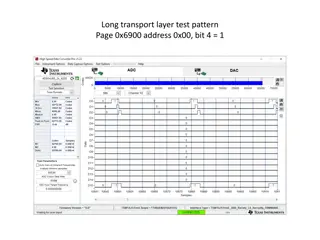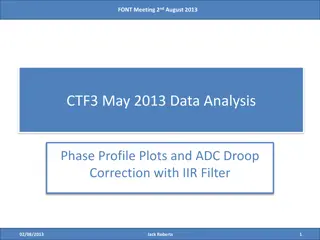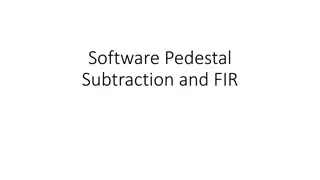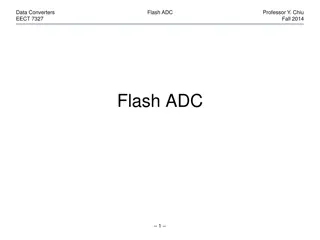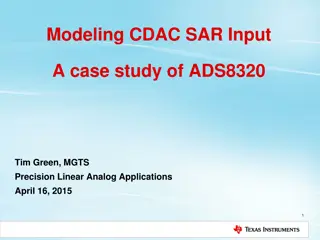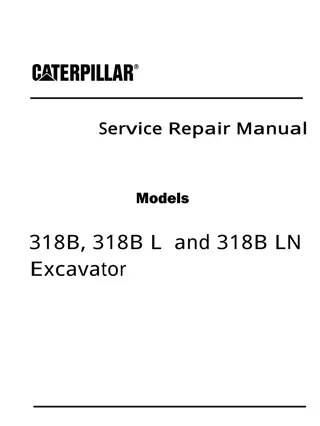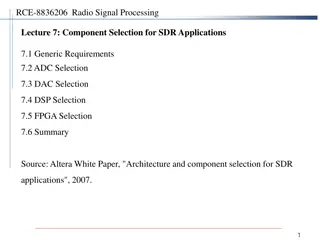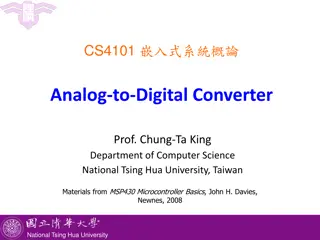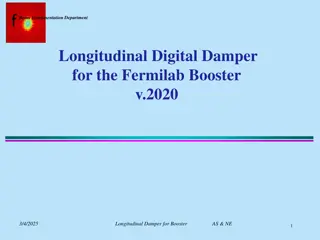
Lab 5: Analog-to-Digital Converter in Embedded Systems
Explore the Analog-to-Digital Converter (ADC) of MSP430 in this lab at National Tsing Hua University. Learn about ADC configuration, ADC10 usage for temperature measurement, ADC10 registers, enabling sampling and conversion, steps for single conversion, and ideal settings for temperature sensors.
Download Presentation

Please find below an Image/Link to download the presentation.
The content on the website is provided AS IS for your information and personal use only. It may not be sold, licensed, or shared on other websites without obtaining consent from the author. If you encounter any issues during the download, it is possible that the publisher has removed the file from their server.
You are allowed to download the files provided on this website for personal or commercial use, subject to the condition that they are used lawfully. All files are the property of their respective owners.
The content on the website is provided AS IS for your information and personal use only. It may not be sold, licensed, or shared on other websites without obtaining consent from the author.
E N D
Presentation Transcript
CS4101 Introduction to Embedded Systems Lab 5: Analog-to-Digital Converter Prof. Chung-Ta King Department of Computer Science National Tsing Hua University, Taiwan National Tsing Hua University
Introduction In this lab, we will learn ADC of MSP430 Configuration of ADC10 Use of ADC10 to measure the temperature of LauchPad 1 National Tsing Hua University
Simplified Block Diagram of ADC10 Voltage reference Clock sources Conversion trigger 2 National Tsing Hua University
ADC10 Registers Register Type Register Short Form Addr. Initial State ADC10 input enable register 0 ADC10AE0 Read/write 04Ah Reset with POR ADC10 input enable register 1 ADC10AE1 Read/write 04Bh Reset with POR ADC10 control register 0 ADC10CTL0 Read/write 01B0h Reset with POR Reset with POR ADC10 control register 1 ADC10CTL1 Read/write 01B2h ADC10 memory ADC10MEM Read 01B4h Unchanged ADC10 data transfer control register 0 ADC10DTC0 Where the data is saved Read/write 048h Reset with POR ADC10 data transfer control register 1 ADC10DTC1 Read/write 049h Reset with POR ADC10 data transfer start address ADC10SA Read/write 01BCh 0200h with POR 3 National Tsing Hua University
Enabling Sampling and Conversion 4 National Tsing Hua University
Steps for Single Conversion (1) Configure ADC10, including the ADC10ON bit to enable the module. The ENC bit must be clear so that most bits in ADC10CTL0 and ADC10CTL1 can be changed. (2) Set the ENC bit to enable a conversion. This cannot be done if the module is being configured in (1). (3) Trigger the conversion. This is done either by setting the ADC10SC bit or by an edge from Timer_A. ADC10ON, ENC, ADC10SC are all in control register ADC10CTL0 5 National Tsing Hua University
ADC10CTL0 ideal for the temperature sensor ideal for the temperature sensor 6 National Tsing Hua University
ADC10CTL0 contd ADC10CTL0 = SREF_2 + ADC10SHT_1; // Reference range & SH time 7 National Tsing Hua University
ADC10CTL1 8 National Tsing Hua University
ADC10CTL1 contd ADC10CTL1 = INCH_10 + ADC10DIV_0; // Temp Sensor ADC10CLK 9 National Tsing Hua University
Sample Code 1 for ADC10 Repetitive single conversion: A single sample is made on A1 (pin P1.1) with reference to Vcc If A1 > 0.5*Vcc, P1.0 set, else reset. Software sets ADC10SC to start sample and conversion. ADC10SC automatically cleared at end of conversion. Use ADC10 internal oscillator to time the sample and conversion. 10 National Tsing Hua University
Sample Code 1 for ADC10 #include "msp430.h" void main(void) { WDTCTL = WDTPW + WDTHOLD; // Stop WDT // H&S time 16x, interrupt enabled ADC10CTL0 = ADC10SHT_2 + ADC10ON + ADC10IE; ADC10CTL1 = INCH_1; // Input from A1 ADC10AE0 |= 0x02; // Enable pin A1 for analog in P1DIR |= 0x01; // Set P1.0 to output ADC10CTL0 |= ENC + ADC10SC; // Start sampling for (;;) { } } #pragma vector=ADC10_VECTOR __interrupt void ADC10_ISR(void) { if (ADC10MEM < 0x1FF) P1OUT &= ~0x01; else P1OUT |= 0x01; ADC10CTL0 |= ENC + ADC10SC; // enable sampling } 11 National Tsing Hua University
Sample Code 2 for ADC10 Continuous sampling driven by Timer0_A A1 is sampled 16/second (ACLK/2048) with reference to 1.5V, where ACLK runs at 32 KHz driven by an external crystal. If A1 > 0.5Vcc, P1.0 is set, else reset. Timer0_A is run in up mode and its CCR1 is used to automatically trigger ADC10 conversion, while CCR0 defines the sampling period Use internal oscillator times sample (16x) and conversion (13x). 12 National Tsing Hua University
Sample Code 2 for ADC10 #include "msp430.h int i=1; void main(void) { WDTCTL = WDTPW + WDTHOLD; // Stop WDT // TA1 trigger sample start ADC10CTL1 = SHS_1 + CONSEQ_2 + INCH_1; ADC10CTL0 = SREF_1 + ADC10SHT_2 + REFON + ADC10ON + ADC10IE; __enable_interrupt(); // Enable interrupts TA0CCR0 = 30; // Delay for Volt Ref to settle TA0CCTL0 |= CCIE; // Compare-mode interrupt TA0CTL = TASSEL_2 + MC_1; // SMCLK, Up mode while(i); // Wait for settle TA0CCTL0 &= ~CCIE; // Disable timer Interrupt __disable_interrupt(); 13 National Tsing Hua University
Sample Code 2 for ADC10 ADC10CTL0 |= ENC; // ADC10 Enable ADC10AE0 |= 0x02; // P1.1 ADC10 option select P1DIR |= 0x01; // Set P1.0 output TA0CCR0 = 2048-1; // Sampling period TA0CCTL1 = OUTMOD_3; // TACCR1 set/reset TA0CCR1 = 2046; // TACCR1 OUT1 on time TA0CTL = TASSEL_1 + MC_1; // ACLK, up mode while(1); } Timer0_A CCR1 out mode 3: The output (OUT1) is set when the timer counts to the TA0CCR1 value. It is reset when the timer counts to the TA0CCR0 value. 14 National Tsing Hua University
Sample Code 2 for ADC10 // ADC10 interrupt service routine #pragma vector=ADC10_VECTOR __interrupt void ADC10_ISR(void){ if (ADC10MEM < 0x155) // ADC10MEM = A1 > 0.5V? P1OUT &= ~0x01; // Clear P1.0 LED off else P1OUT |= 0x01; // Set P1.0 LED on } #pragma vector=TIMERA0_VECTOR __interrupt void ta0_isr(void){ TA0CTL = 0; i = 0 } 15 National Tsing Hua University
Lab 5 Basic 1: Flash red and green LED at 1 Hz based on the interrupt from TA1R of Timer1_A driven by ACLK sourced by VLO. The red LED should be on for 0.4 sec and off for 0.6 sec based on the interrupt from TA1CCR0. The green LED should be on for 0.2 sec and off for 0.8 sec, based on the interrupt from TA1CCR1. Enable button interrupt. Every time the button is pushed, measure the temperature, convert it to Celsius scale, and assign it into a variable. Show the value of the variable in the debug mode of CCS. Lab 4 Basic 1 16 National Tsing Hua University
Lab 5 Basic 1: (cont d) Use 1.5V voltage reference. Choose single-channel-single- conversion as the conversion sequence mode and ADC10SC as the triggering source. Hint: V = 0.00355 * C + 0.986, where V is Voltage and C is Celsius 17 National Tsing Hua University
Lab 5 Basic 2: Measure the temperature of MSP430 every 0.5 second. Flash both LEDs at 1 Hz if the average temperature of the last 2 seconds remains unchanged between two consecutive measurements. Flash the red LED at 2 Hz if the average temperature rises and the green LED at 1 Hz if it drops. Choose repeat-single-conversion as the conversion sequence mode The sampling of ADC10 must be triggered continuously by Timer0_A. 18 National Tsing Hua University
Lab 5 Bonus: Repeat Basic 2 but handle all the events (timer up, DAC done, ) with interrupts. 19 National Tsing Hua University



